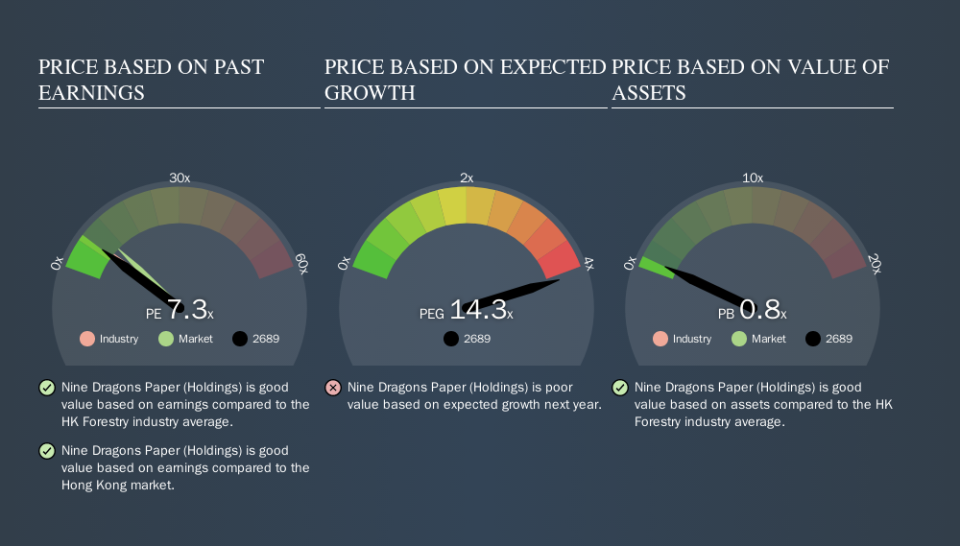Do You Know What Nine Dragons Paper (Holdings) Limited's (HKG:2689) P/E Ratio Means?

The goal of this article is to teach you how to use price to earnings ratios (P/E ratios). We'll apply a basic P/E ratio analysis to Nine Dragons Paper (Holdings) Limited's (HKG:2689), to help you decide if the stock is worth further research. Nine Dragons Paper (Holdings) has a price to earnings ratio of 7.33, based on the last twelve months. That corresponds to an earnings yield of approximately 13.6%.
See our latest analysis for Nine Dragons Paper (Holdings)
How Do I Calculate Nine Dragons Paper (Holdings)'s Price To Earnings Ratio?
The formula for P/E is:
Price to Earnings Ratio = Share Price (in reporting currency) ÷ Earnings per Share (EPS)
Or for Nine Dragons Paper (Holdings):
P/E of 7.33 = HK$6.05 (Note: this is the share price in the reporting currency, namely, CNY ) ÷ HK$0.82 (Based on the year to June 2019.)
Is A High Price-to-Earnings Ratio Good?
A higher P/E ratio means that investors are paying a higher price for each HK$1 of company earnings. That is not a good or a bad thing per se, but a high P/E does imply buyers are optimistic about the future.
Does Nine Dragons Paper (Holdings) Have A Relatively High Or Low P/E For Its Industry?
We can get an indication of market expectations by looking at the P/E ratio. We can see in the image below that the average P/E (8.3) for companies in the forestry industry is higher than Nine Dragons Paper (Holdings)'s P/E.
This suggests that market participants think Nine Dragons Paper (Holdings) will underperform other companies in its industry. Many investors like to buy stocks when the market is pessimistic about their prospects. It is arguably worth checking if insiders are buying shares, because that might imply they believe the stock is undervalued.
How Growth Rates Impact P/E Ratios
Generally speaking the rate of earnings growth has a profound impact on a company's P/E multiple. Earnings growth means that in the future the 'E' will be higher. That means even if the current P/E is high, it will reduce over time if the share price stays flat. So while a stock may look expensive based on past earnings, it could be cheap based on future earnings.
Nine Dragons Paper (Holdings)'s earnings per share fell by 51% in the last twelve months. But it has grown its earnings per share by 17% per year over the last five years.
Remember: P/E Ratios Don't Consider The Balance Sheet
One drawback of using a P/E ratio is that it considers market capitalization, but not the balance sheet. Thus, the metric does not reflect cash or debt held by the company. In theory, a company can lower its future P/E ratio by using cash or debt to invest in growth.
While growth expenditure doesn't always pay off, the point is that it is a good option to have; but one that the P/E ratio ignores.
Is Debt Impacting Nine Dragons Paper (Holdings)'s P/E?
Nine Dragons Paper (Holdings)'s net debt is 80% of its market cap. If you want to compare its P/E ratio to other companies, you should absolutely keep in mind it has significant borrowings.
The Verdict On Nine Dragons Paper (Holdings)'s P/E Ratio
Nine Dragons Paper (Holdings) trades on a P/E ratio of 7.3, which is below the HK market average of 10.3. When you consider that the company has significant debt, and didn't grow EPS last year, it isn't surprising that the market has muted expectations.
When the market is wrong about a stock, it gives savvy investors an opportunity. As value investor Benjamin Graham famously said, 'In the short run, the market is a voting machine but in the long run, it is a weighing machine. So this free visual report on analyst forecasts could hold the key to an excellent investment decision.
Of course, you might find a fantastic investment by looking at a few good candidates. So take a peek at this free list of companies with modest (or no) debt, trading on a P/E below 20.
We aim to bring you long-term focused research analysis driven by fundamental data. Note that our analysis may not factor in the latest price-sensitive company announcements or qualitative material.
If you spot an error that warrants correction, please contact the editor at editorial-team@simplywallst.com. This article by Simply Wall St is general in nature. It does not constitute a recommendation to buy or sell any stock, and does not take account of your objectives, or your financial situation. Simply Wall St has no position in the stocks mentioned. Thank you for reading.

